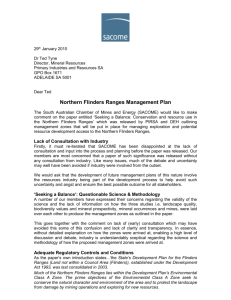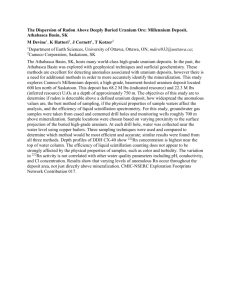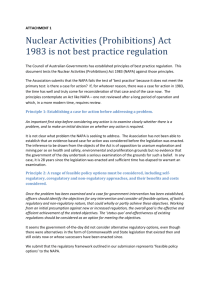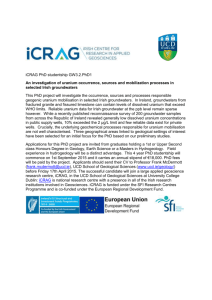From: Michael Angwin (personal contact details deleted) Sent
advertisement
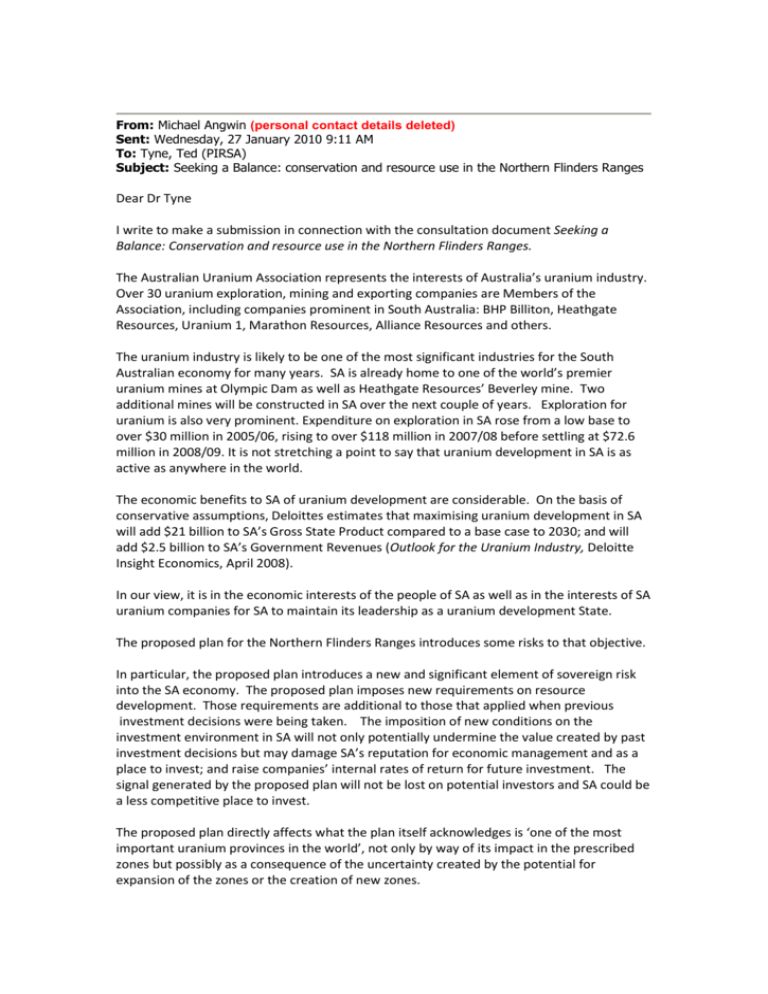
From: Michael Angwin (personal contact details deleted) Sent: Wednesday, 27 January 2010 9:11 AM To: Tyne, Ted (PIRSA) Subject: Seeking a Balance: conservation and resource use in the Northern Flinders Ranges Dear Dr Tyne I write to make a submission in connection with the consultation document Seeking a Balance: Conservation and resource use in the Northern Flinders Ranges. The Australian Uranium Association represents the interests of Australia’s uranium industry. Over 30 uranium exploration, mining and exporting companies are Members of the Association, including companies prominent in South Australia: BHP Billiton, Heathgate Resources, Uranium 1, Marathon Resources, Alliance Resources and others. The uranium industry is likely to be one of the most significant industries for the South Australian economy for many years. SA is already home to one of the world’s premier uranium mines at Olympic Dam as well as Heathgate Resources’ Beverley mine. Two additional mines will be constructed in SA over the next couple of years. Exploration for uranium is also very prominent. Expenditure on exploration in SA rose from a low base to over $30 million in 2005/06, rising to over $118 million in 2007/08 before settling at $72.6 million in 2008/09. It is not stretching a point to say that uranium development in SA is as active as anywhere in the world. The economic benefits to SA of uranium development are considerable. On the basis of conservative assumptions, Deloittes estimates that maximising uranium development in SA will add $21 billion to SA’s Gross State Product compared to a base case to 2030; and will add $2.5 billion to SA’s Government Revenues (Outlook for the Uranium Industry, Deloitte Insight Economics, April 2008). In our view, it is in the economic interests of the people of SA as well as in the interests of SA uranium companies for SA to maintain its leadership as a uranium development State. The proposed plan for the Northern Flinders Ranges introduces some risks to that objective. In particular, the proposed plan introduces a new and significant element of sovereign risk into the SA economy. The proposed plan imposes new requirements on resource development. Those requirements are additional to those that applied when previous investment decisions were being taken. The imposition of new conditions on the investment environment in SA will not only potentially undermine the value created by past investment decisions but may damage SA’s reputation for economic management and as a place to invest; and raise companies’ internal rates of return for future investment. The signal generated by the proposed plan will not be lost on potential investors and SA could be a less competitive place to invest. The proposed plan directly affects what the plan itself acknowledges is ‘one of the most important uranium provinces in the world’, not only by way of its impact in the prescribed zones but possibly as a consequence of the uncertainty created by the potential for expansion of the zones or the creation of new zones. The Association wishes to draw attention to a number of puzzling aspects of the plan. It is not clear to the Association why it has been necessary to propose new arrangements for the Northern Flinders Ranges. As the proposed plan itself says, ‘Much of the Northern Flinders Ranges lies within the Development Plan’s (that is, Development Plan for the Northern Flinders Ranges) Environmental Class A Zone. The prime objectives of the Environmental Class A Zone seek to conserve the natural character and environment of the area and to protect the landscape from damage by mining operations and exploring for new resources. Reflecting these objectives, Government already places strict conditions and regulatory controls on mineral and energy exploration and on proposed mining activities in the region.’ While it is understandable that governments wish to ‘further refine’ existing policies over time, as the proposed plan says is its intent for the Northern Flinders Ranges, it is far from clear how the existing Development Plan has failed in its aspirations and, hence, why a new plan is needed. The proposed plan gives no indication of what damage exploration and mining has caused the region or how or why the existing ‘strict conditions and regulatory controls’ have failed to protect the region from damage. It seems to the Association that, in the absence of data or study on those issues, the case for further refinement of existing policies is a weak one. A second puzzling aspect of the proposed new plan is the methodology employed to identify the north eastern corner of the Northern Flinders Ranges as the area where management arrangements need to be improved. A series of maps displays the fact that mineral prospectivity values and environmental values coincide or overlap. The plan moves from that fact to the identification of zones and the conditions that apply within them without discussion of: The relationship between those two sets of values Why some activities should be permitted and others not. For example, on the face of it, landform disturbance is permitted in zone 2a but not in zone 2b; why should temporary ground disturbing activities be permitted in zone 2b but not in zone 2a; what is the rational for permitting mining in zone 2a if access is from outside the zone but not applying the same condition to zone 2b The different treatment of different zones. For example, the differences between Access Zone 2a and Zone 2b are vague. The conditions for Zone 2a specify ‘No high impact activities accepted’ while zone 2b specifies ‘Low impact activities permitted’. It is not clear what the difference is. The two descriptors could mean the same thing. A third puzzling aspect is that the plan prescribes activities that are to be permitted or not. This is a sharp departure from the regulatory practices that have developed in this area over the past 20 or so years by which governments determine the outcomes they require and hold businesses to account for achieving those outcomes. The new plan is a reversion to the past in attempting to regulate how companies achieve outcomes. In short, the plan fails to make the case for ‘further refinement’ of the existing Flinders Ranges Development Plan, does not make the case for the specific conditions it proposes, is only vaguely and inadequately explained and reverts to regulatory practices that have mostly been abandoned. The increase in sovereign risk in ‘one of the most important uranium provinces in the world’ seems a large price to pay for such a policy. The Association would be prepared to respond to any requests for further information or views. Your sincerely Michael Angwin | Chief Executive Officer | Australian Uranium Association | (personal contact details deleted)



